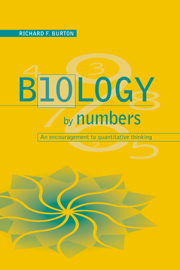Book contents
- Frontmatter
- Contents
- Preface
- A guide to the book
- 1 Putting two and two together
- 2 Units, formulae and the use of old envelopes: confronting some obstacles to quantitative thinking
- 3 Aspects of energy metabolism
- 4 Getting things in proportion
- 5 Perilous percentages, dangerous ratios
- 6 Building a trophic pyramid
- 7 Sodium in animals and plants
- 8 Exchanges of water and carbon dioxide
- 9 A geometric series
- 10 Introduction to logarithms
- 11 Bringing logarithms to life
- 12 Exponential relationships
- 13 Aspects of allometry
- 14 More on allometry, and on quantitative patterns in nature
- 15 How the abundance of food affects rates of feeding
- 16 The characterization of trees and other branching systems
- 17 Epilogue
- References
- Notes
- Index
14 - More on allometry, and on quantitative patterns in nature
Published online by Cambridge University Press: 05 June 2012
- Frontmatter
- Contents
- Preface
- A guide to the book
- 1 Putting two and two together
- 2 Units, formulae and the use of old envelopes: confronting some obstacles to quantitative thinking
- 3 Aspects of energy metabolism
- 4 Getting things in proportion
- 5 Perilous percentages, dangerous ratios
- 6 Building a trophic pyramid
- 7 Sodium in animals and plants
- 8 Exchanges of water and carbon dioxide
- 9 A geometric series
- 10 Introduction to logarithms
- 11 Bringing logarithms to life
- 12 Exponential relationships
- 13 Aspects of allometry
- 14 More on allometry, and on quantitative patterns in nature
- 15 How the abundance of food affects rates of feeding
- 16 The characterization of trees and other branching systems
- 17 Epilogue
- References
- Notes
- Index
Summary
This chapter explores the importance of size to biological function – in the context of animals, eggs, plants and wind-borne fruit, of physiology, biomechanics and ecology. In the final Section what vary in size are Pacific islands and their bird populations, measured in terms of numbers of species. As in the previous chapter, general points are made about the interpretation of data.
Surface area/volume relationships
Think of two animals of similar shape, one of 10 g and one of 1000 kg. The latter obviously has the largest area of outer surface, but the smaller animal has 46 times the relative surface area (i.e. area divided by volume). Surface area matters to organisms for various reasons, depending on their nature, but notably because it influences exchanges with the environment – of oxygen, carbon dioxide, light, water, heat and so on. The relationship between surface area and volume (or, much the same thing, between surface area and mass) is therefore of immense importance in comparing organisms of different sizes. The emphasis in this Section is on objects that differ in size but not shape, but it should not be forgotten that it is characteristic of higher plants to grow by adding more modules of similar surface/volume ratio, e.g. twigs and leaves; surface and volume may therefore increase roughly in proportion to each other.
The essential feature of the general relationship between surface area and volume is readily understood in a non-quantitative manner as follows.
- Type
- Chapter
- Information
- Biology by NumbersAn Encouragement to Quantitative Thinking, pp. 157 - 188Publisher: Cambridge University PressPrint publication year: 1998



